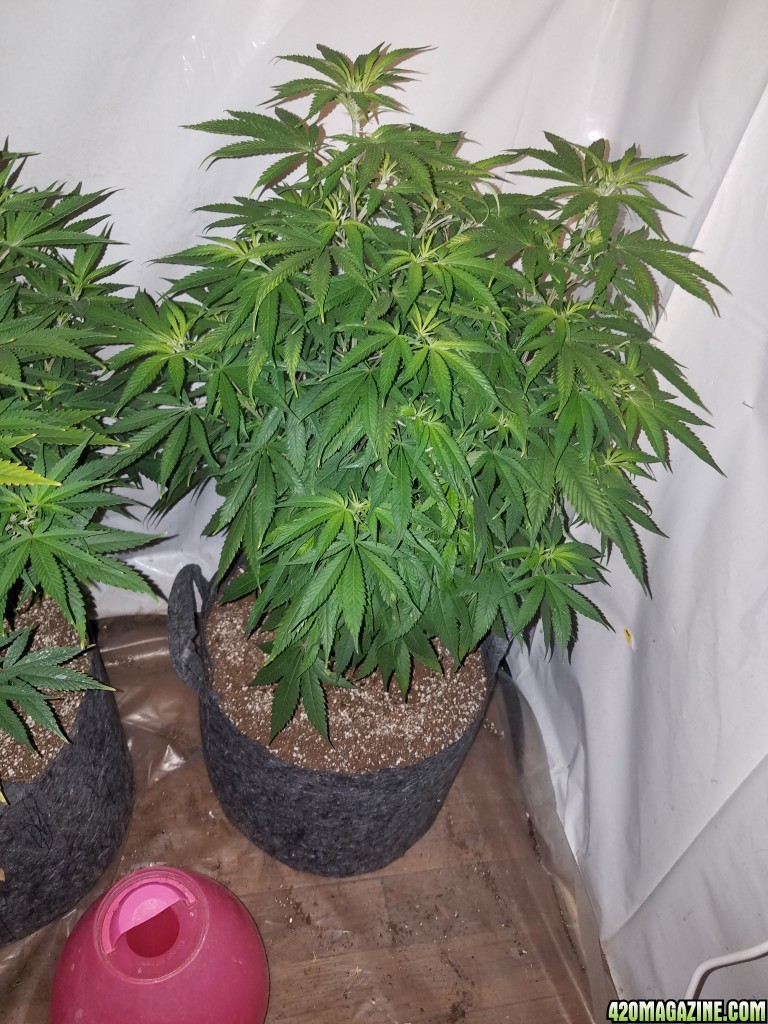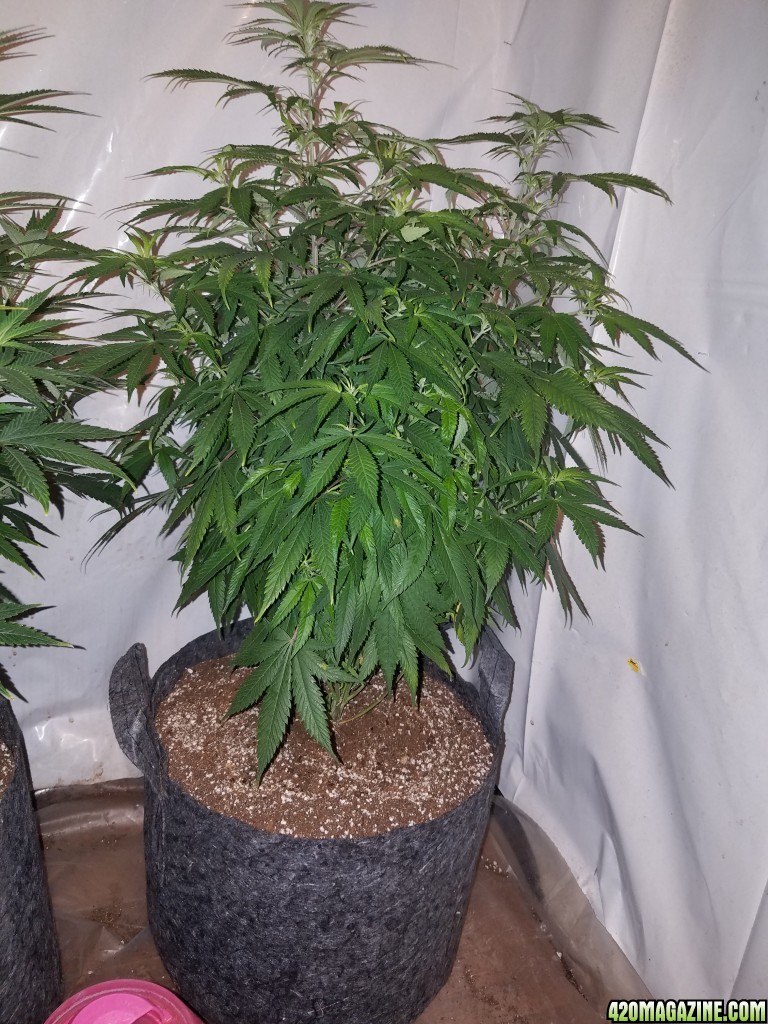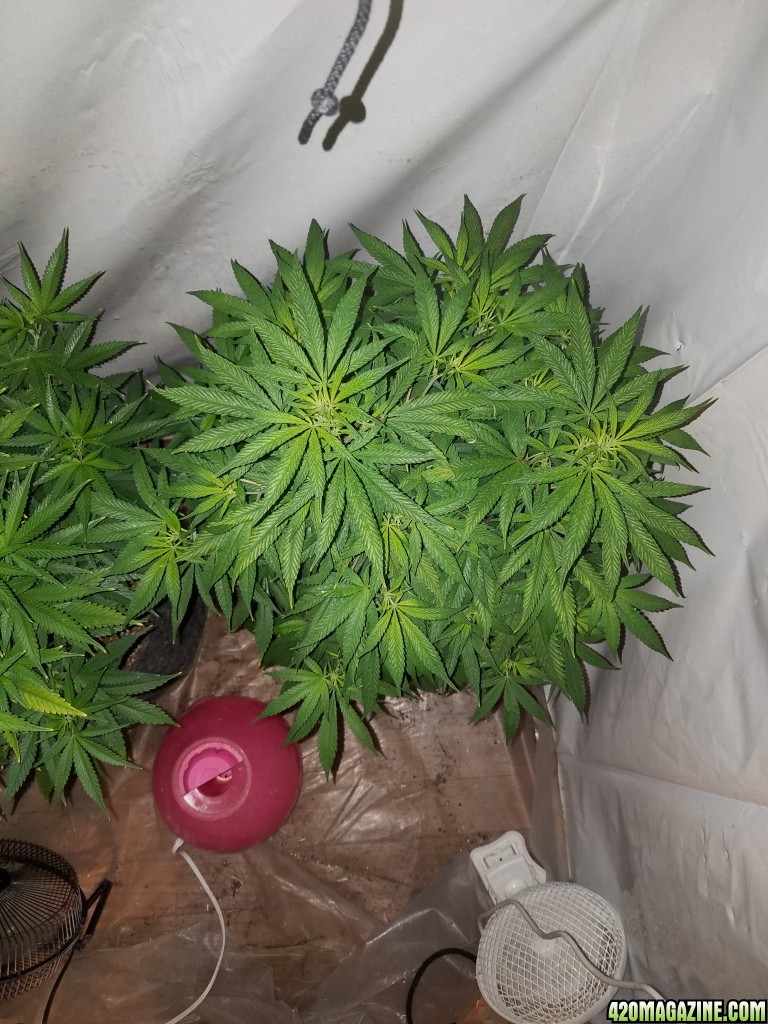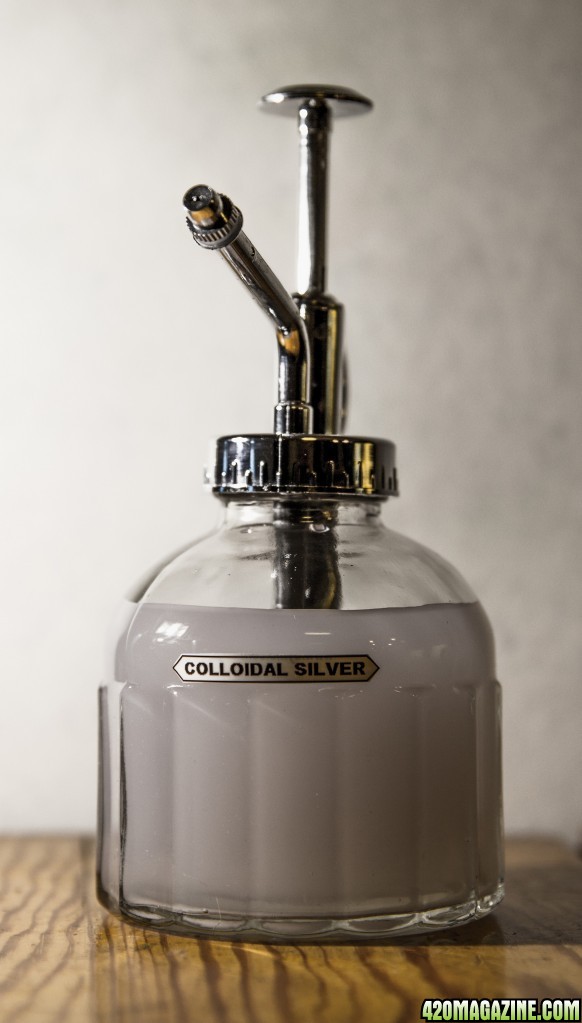Navigation
Install the app
How to install the app on iOS
How To Use Progressive Web App aka PWA On 420 Magazine Forum
Note: This feature may not be available in some browsers.
More options
You are using an out of date browser. It may not display this or other websites correctly.
You should upgrade or use an alternative browser.
You should upgrade or use an alternative browser.
Devil's Carnival: The Community Grow Experience
- Thread starter
- #182
You wouldn't happened to have cloned it by any chance did you? We have pollen or I could walk you through the whole making feminized seeds process.Man Nis, I got this purple pheno looking crazy, I need some pollen so we can try to get these purples!
We have 2 more in veg that i think I am going to clone today and flip to see if either one will be purple like yours. The purple is a must have. Right now our buds are almost pink looking.
JuanCarlos
Well-Known Member
Nice work guys.
Of course I didn't clone it, that's why I am kicking myself! But it's fine, I will get some more going shortly and I will be sure to clone them.
I have read a bit about selfing plants, but I don't currently have any room to experiment, but very soon I will have the opportunity to try new things due to some changes in the grow area.
I have read a bit about selfing plants, but I don't currently have any room to experiment, but very soon I will have the opportunity to try new things due to some changes in the grow area.
Skullman420
Well-Known Member
Is it too late to clone it now? I've been cloning plants almost all the way till harvest. And when I didn't but wanted to keep the genetics, I would just re-vegg the entire plant
Of course I didn't clone it, that's why I am kicking myself! But it's fine, I will get some more going shortly and I will be sure to clone them.
I have read a bit about selfing plants, but I don't currently have any room to experiment, but very soon I will have the opportunity to try new things due to some changes in the grow area.
TheRedDragon
New Member
Some DC pics






Really nice TRD! Looks like a haircut is coming soon?
Skullman420
Well-Known Member
@Nismo or any other who's been through the process of making feminized seeds with colloidal silver. Could any of you give me your five scents on my take on making colloidal silver? Did I do it right and how to figure out it's real strength?
THE 36V COLLOIDAL SILVER GENERATOR
Sorry for asking an unrelated question, but just couldn't help myself in a thread full of breeders
THE 36V COLLOIDAL SILVER GENERATOR
Sorry for asking an unrelated question, but just couldn't help myself in a thread full of breeders
- Thread starter
- #189
@Nismo or any other who's been through the process of making feminized seeds with colloidal silver. Could any of you give me your five scents on my take on making colloidal silver? Did I do it right and how to figure out it's real strength?
THE 36V COLLOIDAL SILVER GENERATOR
Sorry for asking an unrelated question, but just couldn't help myself in a thread full of breeders
If you have a TDS meter to check ppm then that will work. When we used CS it tested at 48 ppm and we were shooting for 50 ppm. A cheap $10 one to check ppm of nutes or water works just fine.
If you can get your hands on some sodium thiosulfate pentahydrate and silver nitrate, I would recommend making some STS. Results are faster and a lot less spraying applications. It's what the pros use and I can see why. It's easy lol. I'll stop by and have a look though.
Skullman420
Well-Known Member
My TDS meter says my first batch is 70 ppm and my second batch is 10 ppm. But sadly it can not be trusted for measuring silver content. In reality my second batch is probably much stronger than the first batch as I "cooked" it for much longer, but made sure to clean the silver so often it did not get a chance to contaminate the water. The reason that a PPM meter is as good as useless is the following (copy/paste from an article - not linking to it in accordance with 420 rules"
"Most people are under the mistaken impression that they can read the concentration of silver in ppm in their colloidal silver with a TDS meter. To understand why it will not read correctly, it is necessary to understand how a TDS meter works.
Inside of a TDS meter is an electrical circuit which measures the resistance between its two electrodes when immersed in a liquid. This circuit applies an AC voltage to the electodes, and then measures the AC current which flows between the two electrodes. This reading is then corrected for temperature (if its a high quality instrument), and electrode geometry. The result is a measure of Total Ionic Content. The name Total Dissolved Solids is actually a misnomer, as a lot of dissolved solids will not read at all on a TDS meter since they do not ionize when they dissolve. Sugar is such a substance. If you were to dissolve a tablespoon of table sugar in a cup of distilled water and read it with a TDS meter, the resulting reading would be zero.
The reason AC is used instead of DC voltage on the electrodes is to keep the metals in the solution from plating onto the electrodes. With AC, anything that plates onto the negative electrode will in theory come off when the polarity reverses. AC also keeps the ions from migrating from one electrode to the other, thereby keeping the solution homogeneous.
Another thing which must be understood is the actual meaning of parts per million (ppm). PPM means the weight of one substance contained in a given weight of another different substance. For example, if a million pounds of bread flour contained 1 pound of dirt, it would be 1 ppm dirt in the flour. We are not interested in flour though, we are interested in silver ions in water. For silver, one PPM means 1 gram of silver in 1 million grams of water, which is equivalent to 1 milligram of silver in 1 kilogram of water. Since water weighs 1 gram per milliliter, this is equivalent to 1 milligram of silver per liter of water.
The problem with measuring silver ions goes back to the what the TDS meter actually measures – electrical current (conductivity). In a solution, electrical current (charge) is carried by ions moving through the solution, and current is actually ions moving per time. It doesn’t matter whether it is a silver ion, or a sodium ion etc. However, not all ions are equal, each kind of ion has a different weight. For example, a single sodium ion weighs 23, while a silver ion weighs 108, or 4.7 times as much as a sodium ion. Yet, the TDS meter cannot distinguish between the two.
Another source of error is that ionic silver is not just silver, it is silver oxide, or silver chloride or some other silver salt. Therefore, the ppm of the colloidal silver will have a different value for the same amount of silver depending on the silver salt present. It is not possible to just have silver ions, there will always be a matching anion present, like hydroxide, chloride, nitrate, etc.
Most TDS meters are calibrated to read a mix of ions normally found in ground and drinking water. This is done by adjusting the circuitry to get a specific reading while the TDS meter electrodes are immersed in a standardized solution of salt. The salt solution is just used as a repeatable reference, and the TDS meter is not calibrated to read the actual ppm of the salt solution.
The result of these considerations is that the only TDS reading that is accurate for silver is ZERO, and any other reading will be incorrect. A TDS meter is not very useful for measuring silver, but is useful for measuring the purity of the water used to make colloidal silver"
"Most people are under the mistaken impression that they can read the concentration of silver in ppm in their colloidal silver with a TDS meter. To understand why it will not read correctly, it is necessary to understand how a TDS meter works.
Inside of a TDS meter is an electrical circuit which measures the resistance between its two electrodes when immersed in a liquid. This circuit applies an AC voltage to the electodes, and then measures the AC current which flows between the two electrodes. This reading is then corrected for temperature (if its a high quality instrument), and electrode geometry. The result is a measure of Total Ionic Content. The name Total Dissolved Solids is actually a misnomer, as a lot of dissolved solids will not read at all on a TDS meter since they do not ionize when they dissolve. Sugar is such a substance. If you were to dissolve a tablespoon of table sugar in a cup of distilled water and read it with a TDS meter, the resulting reading would be zero.
The reason AC is used instead of DC voltage on the electrodes is to keep the metals in the solution from plating onto the electrodes. With AC, anything that plates onto the negative electrode will in theory come off when the polarity reverses. AC also keeps the ions from migrating from one electrode to the other, thereby keeping the solution homogeneous.
Another thing which must be understood is the actual meaning of parts per million (ppm). PPM means the weight of one substance contained in a given weight of another different substance. For example, if a million pounds of bread flour contained 1 pound of dirt, it would be 1 ppm dirt in the flour. We are not interested in flour though, we are interested in silver ions in water. For silver, one PPM means 1 gram of silver in 1 million grams of water, which is equivalent to 1 milligram of silver in 1 kilogram of water. Since water weighs 1 gram per milliliter, this is equivalent to 1 milligram of silver per liter of water.
The problem with measuring silver ions goes back to the what the TDS meter actually measures – electrical current (conductivity). In a solution, electrical current (charge) is carried by ions moving through the solution, and current is actually ions moving per time. It doesn’t matter whether it is a silver ion, or a sodium ion etc. However, not all ions are equal, each kind of ion has a different weight. For example, a single sodium ion weighs 23, while a silver ion weighs 108, or 4.7 times as much as a sodium ion. Yet, the TDS meter cannot distinguish between the two.
Another source of error is that ionic silver is not just silver, it is silver oxide, or silver chloride or some other silver salt. Therefore, the ppm of the colloidal silver will have a different value for the same amount of silver depending on the silver salt present. It is not possible to just have silver ions, there will always be a matching anion present, like hydroxide, chloride, nitrate, etc.
Most TDS meters are calibrated to read a mix of ions normally found in ground and drinking water. This is done by adjusting the circuitry to get a specific reading while the TDS meter electrodes are immersed in a standardized solution of salt. The salt solution is just used as a repeatable reference, and the TDS meter is not calibrated to read the actual ppm of the salt solution.
The result of these considerations is that the only TDS reading that is accurate for silver is ZERO, and any other reading will be incorrect. A TDS meter is not very useful for measuring silver, but is useful for measuring the purity of the water used to make colloidal silver"
If you have a TDS meter to check ppm then that will work. When we used CS it tested at 48 ppm and we were shooting for 50 ppm. A cheap $10 one to check ppm of nutes or water works just fine.
If you can get your hands on some sodium thiosulfate pentahydrate and silver nitrate, I would recommend making some STS. Results are faster and a lot less spraying applications. It's what the pros use and I can see why. It's easy lol. I'll stop by and have a look though.
Skullman420
Well-Known Member
Anyway - Here's how the finished product looked like. It changed color and got more clear over time though.




TheRedDragon
New Member
Really nice TRD! Looks like a haircut is coming soon?
Yeah, they need one bad. Lol
Skullman420
Well-Known Member
Thanks for the tip about odium thiosulfate pentahydrate and silver nitrate Nismo. I appreciate it. Will read about it
- Thread starter
- #194
Not a problem. About the TDS meter, I remember reading about that when we mixed up our first batch of CS. We took I believe 16 ounces of 240 ppm CS and mixed it with 40 oz of distilled water. Math states that it should be 50 ppm and it tested at 48 ppm. So I just took it as it was correct or we just got lucky.Thanks for the tip about odium thiosulfate pentahydrate and silver nitrate Nismo. I appreciate it. Will read about it
Skullman420
Well-Known Member
It doesn't really matter as long as it works. I'll try out my homemade solution and I hope the end result will be feminized seeds. But I fear I am in reality spraying the plants with a very strong solution. I sadly think the only thing I ended up testing with the PPM meter was how much I managed to contaminate the water during the production of the Colloidal silver.
I'll do two tests - one with the Colloidal silver that tested 10 PPM and one with the 70 PPM. In theory they should both manage to hermie the plants.
I have also seen special TDS meters specially calibrated for colloidal silver (at least they claim so) but after doing some research on the subject I have not found a credible way of actually measuring the true PPM.
I'll do two tests - one with the Colloidal silver that tested 10 PPM and one with the 70 PPM. In theory they should both manage to hermie the plants.
I have also seen special TDS meters specially calibrated for colloidal silver (at least they claim so) but after doing some research on the subject I have not found a credible way of actually measuring the true PPM.
Not a problem. About the TDS meter, I remember reading about that when we mixed up our first batch of CS. We took I believe 16 ounces of 240 ppm CS and mixed it with 40 oz of distilled water. Math states that it should be 50 ppm and it tested at 48 ppm. So I just took it as it was correct or we just got lucky.
One week old now.



Interesting color. Quite unique.
Interesting color. Quite unique.
- Thread starter
- #197
Day 52

Im going to watch how these all come out for you. Some interesting colors are coming through.
My two girls, green pheno and purple pheno are both cruising along in bloom nicely. Green pheno is probably about two weeks from the chop and purple is a month or so out. The green pheno has a bit or purple in it and is foxtailing a bit right now at the finish. Looking about average on the yield but smells incredible. Excited to see how these girls turn out!
Blazinjones
Well-Known Member
Question to get this strain did u guys cross dark devil auto with carnival photo period plants?? Also if so who was the breeder jus wondering how i can make this strain or order it


